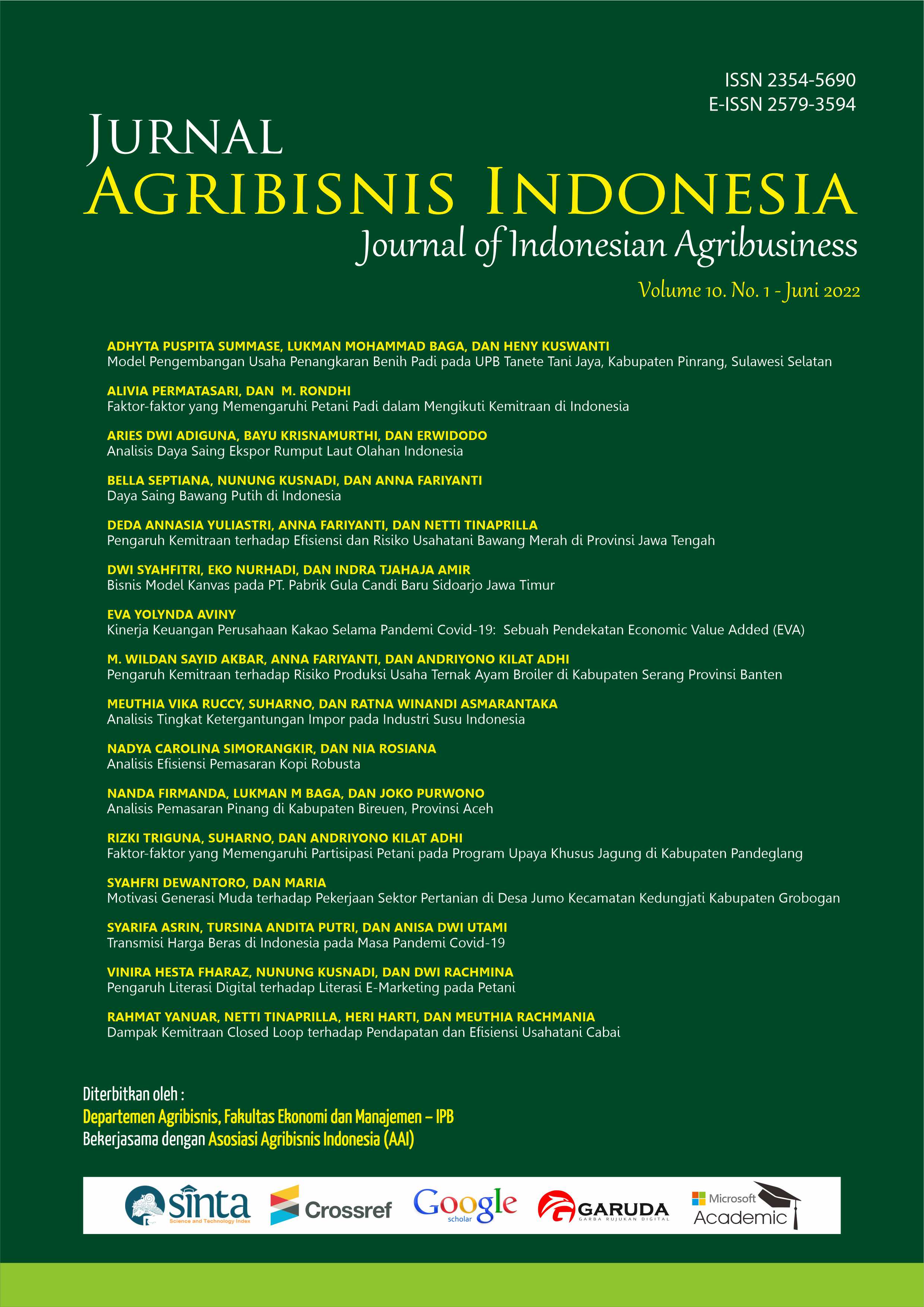Pengaruh Literasi Digital Terhadap Literasi E-Marketing Pada Petani
Main Article Content
Abstract
E-marketing has various advantages and can be used as an alternative for marketing. However, the use of e-marketing in the agricultural sector is still low even though the agricultural sector has the potential to be developed in the form of e-marketing. The use of e-marketing requires farmers to have the ability to master technology or known as digital literacy skills. The higher digital literacy of farmers is expected to increase e-marketing literacy in the agricultural sector. The study aims to measure the level of digital literacy and e-marketing literacy of farmers and analyze the effect of digital literacy on the e-marketing literacy of farmers. The sample used in the study was a 21 samples farmers who partnered with Sayurbox. The level of digital literacy and e-marketing literacy among farmers is measured by Partial Least Square Path Modeling (PLSPM). In addition, the analysis of factors affecting digital literacy and e-marketing literacy of farmers used multiple linear regressions. The results showed that farmers' level of digital literacy and e-marketing literacy was in the moderate category. In the digital literacy section, farmers have weaknesses in the sub-construct of information retrieval and the security and the use of technology. Meanwhile, in e-marketing literacy, farmers have weaknesses in developing information sub-construct that received. Then, digital literacy has a significant positive effect on e-marketing literacy. It showed that digital literacy can measure a farmer's e-marketing literacy. Meanwhile, education significantly affected digital and e-marketing literacy, while age has a significant positive effect on e-marketing literacy.
Downloads
Article Details

This work is licensed under a Creative Commons Attribution 4.0 International License.
Jurnal Agribisnis Indonesia (JAI) is an Open Access Journal. The authors who publish the manuscript in this journal agree to the following terms:
Creative Commons License
JAI is licensed under a Creative Commons Attribution 4.0 International License. This permits anyone to copy, redistribute, remix, transmit, and adapt the work provided the original work and source are appropriately cited.
This means:
(1) Under the CC-BY license, authors retain ownership of the copyright for their article, but authors grant others permission to use the content of publications in Jurnal Agribisnis Indonesia in whole or in part provided that the original work is properly cited. Users (redistributors) of JAI are required to cite the original source, including the author's name, JAI as the initial source of publication, year of publication, volume number, issue, and Digital Object Identifier (DOI); (2) Authors grant JAI the right of first publication. Although authors remain the copyright owner.
References
Alavion S. J., Allahyari, M. S., Al-Rimawi, A. S., Surujlal, J. (2017). Adoption of Agricultural E-Marketing: Application of the Theory of Planned Behavior. Journal of International Food & Agribusiness Marketing. 29(1), 1–15.doi:10.1080/08974438.2016.1229242.
[APJII] Asosiasi Penyelenggara Jasa Internet Indonesia. 2021. Laporan Survei Internet APJII 2019-2020. APJII. Jakarta.
Bhosage, S. M. (2018). E- Marketing of Agricultural Products. IJTSRD. DOI:10.31142/ijtsrd18675.
[GTBC] Google, Temasek, dan Bain & Company. 2019. e-conomy SEA 2019 report. Google danTamasek.
Hair, F. Jr. J., Sarstedt, M., Hopkins, L. G., & Kuppelwieser, V. (2014). Partial least squares structural equation modeling (PLS-SEM): An emerging tool in business research. European Business Review. 26(2), 106–121. DOI:10.1108/EBR-10-2013-0128.
Higgins, G. E., Wolfe, S. E., & Catherine, D. (2014). Digital Piracy: an Examination of Three Measurements of Self- Control. December 2014, pp. 37–41. DOI:10.1080/01639620701598023.
Kotler, P. & Amstrong, G. 2004. Marketing an Introduction. 7th Edition. Prentice Hall International, Inc: New York.
Martin, A., & Grudziecki, J. (2006). DigEuLit: Concepts and Tools for Digital Literacy Development. Innovation in Teaching and Learning in Information and Computer Sciences. 5(4), 249–267. DOI:10.11120/ital.2006.05040249.
Nasri, W., & Charfeddine, L. (2012). Factors affecting the adoption of Internet banking inTunisia: An integration theory of acceptance model and theory of planned behavior. Journal of High Technology Management Research. 23, 1–14. doi:10.1016/j.hitech.2012.03.001
Nugroho, R. A., Basari, A., Suryaningtyas, V. W., & Cahyono, S. P. (2020). University Students’ Perception of Online Learning in Covid-19 Pandemic : A Case Study in a Translation Course. Di dalam: 2020 International Seminar on Application for Technology of Information and Communication (ISemantic). Semarang, Indonesia: IEEE. hlm. 225–231.
Omar, A., Ramayah, T., Lin, L. B., Mohamad, O., & Marimuthu, M. (2011). Determining factors for the usage of web-based marketing applications by small and medium enterprises (SMEs) in Malaysia. Journal of Marketing Development and Competitiveness, 5(2), 70–86.
Phuapan, P., Viriyavejakul, C., Pimdee, P. (2016). An Analysis of Digital Literacy Skills among Thai University Seniors. Int. J. Emerg. Technol. Learn. 11(03):24. DOI:10.3991/ijet.v11i03.5301.
Putera PAJ dan Jasmine Y. 2019. Indonesia Agritech Report 2019. CompassList Pte Ltd.
Raya, A. B., Wastutiningsih, S. P., Penggalih, P. M., Sari, S. P., & Purwani, D. A. (2017). Tantangan Literasi Informasi Petani di Era Informasi: Studi Kasus Petani di Lahan Pasir Pantai Daerah Istimewa Yogyakarta. Jurnal Sosial Ekonomi Pertanian. 10(1):10. DOI :10.19184/jsep.v10i1.5219.
Sanchez G. 2013. PLS Path Modelling with R. Trowchez Editions. Berkeley.

